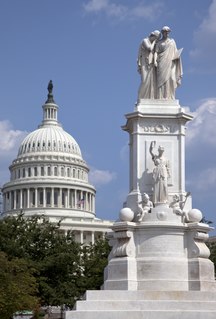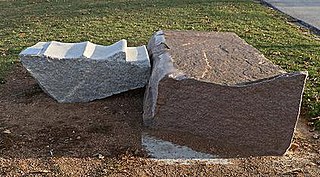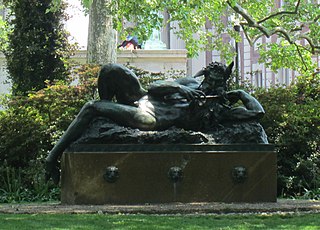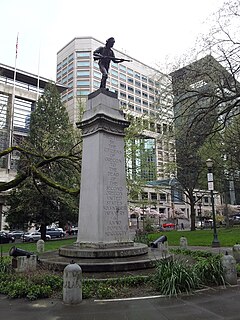
The Peace Monument, also known as the Naval Monument or Civil War Sailors Monument, stands on the grounds of the United States Capitol in Peace Circle at First Street, N.W., and Pennsylvania Avenue, Washington, D.C. The 44 foot high white marble memorial was erected from 1877 to 1878 in commemoration of the naval deaths at sea during the American Civil War. Today it stands as part of a three-part sculptural group including the James A. Garfield Monument and the Ulysses S. Grant Memorial.

The Younger Memnon is an Ancient Egyptian statue, one of two colossal granite heads from the Ramesseum mortuary temple in Thebes, Upper Egypt. It depicts the Nineteenth Dynasty Pharaoh Ramesses II wearing the Nemes head-dress with a cobra diadem on top. The damaged statue has since lost its body and lower legs. It is one of a pair that originally flanked the Ramesseum's doorway. The head of the other statue is still found at the temple.
James W. Washington Jr. was an American painter and sculptor who grew into prominence in the Seattle, Washington, art community.

Spirit of Commerce is a public artwork by German artist Gustav Haug located in Jackson Park, which is on the south side of Milwaukee, Wisconsin. This zinc sculpture is 15 feet tall and sits on a red granite pedestal near the park's lagoon. It is the oldest public sculpture in Milwaukee.

The George Gordon Meade Memorial, also known as the Meade Memorial or Major General George Gordon Meade, is a public artwork in Washington, D.C. honoring George Meade, a career military officer from Pennsylvania who is best known for defeating General Robert E. Lee at the Battle of Gettysburg. The monument is sited on the 300 block of Pennsylvania Avenue NW in front of the E. Barrett Prettyman United States Courthouse. It was originally located at Union Square, but was removed and placed in storage for fourteen years before being installed at its current location. The statue was sculpted by Charles Grafly, an educator and founder of the National Sculpture Society, and was a gift from the state of Pennsylvania. Prominent attendees at the dedication ceremony in 1927 included President Calvin Coolidge, Governor John Stuchell Fisher, Secretary of the Treasury Andrew W. Mellon, and Senator Simeon D. Fess.

John J. Pershing General of the Armies, is a public artwork by American artist Robert White, located at Pershing Park in Washington, D.C., United States. John J. Pershing General of the Armies was originally surveyed as part of the Smithsonian's Save Outdoor Sculpture! survey in 1994. The monument is a tribute to United States Army general John J. Pershing.

The Coal Miner is a public artwork by Polish American artist John J. Szaton (1907–1966) which is located in two US State capitals; the original, commissioned in 1963 in Springfield, Illinois, as well as a copy on the west lawn of the Indiana State House in Indianapolis, Indiana The statues commemorate coal miners who had lost their lives in those states' mining industry. The 7-foot (2.1 m) tall statue rests on a 3-foot (0.91 m) square, granite base supported by a cement foundation that is 4–6 inches (100–150 mm) thick.

Holocaust Memorial is a public artwork by American artist Claire Lieberman located on the Jewish Museum Milwaukee lawn, which is near downtown Milwaukee, Wisconsin, United States. It is located at 1360 North Prospect Ave. This piece is 10 ft x 24 ft x 20 ft. The materials used are Corten steel, black granite, and brick. The Holocaust Memorial was created in 1983.

Two Figures is a bronze sculpture by the English sculptor Barbara Hepworth, which was cast in an edition of seven copies. One of these is located at Newfields, the campus that also houses the Indianapolis Museum of Art in Indianapolis, Indiana. Other casts are at Southampton University, the Fred Jones Jr. Museum of Art at the University of Oklahoma, Commonwealth Park in Canberra Australia, and the Hakone Open-Air Museum, Hakone, Japan. The series were cast at the Morris Singer Foundry in London from 1968 onwards. Another cast of this work could also be found at the University of Birmingham Vale site, but is no longer present as of January 2, 2012.

Referee is a public artwork by American artist Tom Queoff, located on the south entrance of the U.S. Cellular Arena, which is in Milwaukee, Wisconsin, United States. The 9 foot laminated marble sculpture depicts an abstracted referee with legs spread apart and arms raised.

The Progress of Railroading is group of public artworks by American artist Louis Saint-Gaudens. This series of six sculptures were cut by Andrew E. Bernasconi, a high-grade Italian stone workman, between 1909 and 1911. These statues are located at Union Station in Washington, D.C., United States. The sculptures represent deities related to rail transport in the United States.

The Daguerre Memorial is a bronze sculpture by Jonathan Scott Hartley in Washington, D.C. It was erected in memory of Louis Daguerre.

The Andrew W. Mellon Memorial Fountain is a bronze fountain sculpture by Sidney Waugh as a memorial to Andrew W. Mellon. It is located at the eastern tip of the Federal Triangle within the intersection of Pennsylvania Avenue, Constitution Avenue, and 6th Street NW in Washington D.C., United States. The fountain is across Constitution Avenue from the West Building of the National Gallery of Art. The Department of the Interior maintains the fountain, which President Harry S. Truman dedicated on May 9, 1952.

Edge Elements is a public sculpture by Richard Hansen located at South Shore Park on the south side of Milwaukee, Wisconsin. Edge Elements is a series of five sculptures. The group of sculptures was commissioned by the Milwaukee County Percent for Art Program.

A Beam of Sun to Shake the Sky is a public art work by American artist Richard Taylor, located in downtown Milwaukee, Wisconsin. The sculpture was created for the Central Milwaukee Public Library as part of the remodeling of the Wells Street entrance.

The Great God Pan is a bronze sculpture by American sculptor George Grey Barnard. Since 1907, it has been a fixture of the Columbia University campus in Manhattan, New York City.

The Spanish–American War Soldier's Monument, also known as the Spanish–American War Memorial or simply Soldiers Monument, is an outdoor sculpture and war memorial monument honoring the 2nd Oregon Volunteer Infantry Regiment of the Spanish–American War, created by American artist Douglas Tilden and located in Lownsdale Square, in the Plaza Blocks of downtown Portland, Oregon. It features a bronze statue on a marble pedestal and granite base. The monument is part of the City of Portland and Multnomah County Public Art Collection courtesy of the Regional Arts & Culture Council.

In the Shadow of the Elm is an outdoor 1984 sculpture by Paul Sutinen, located at the South Park Blocks in Portland, Oregon.

The Family is an outdoor bronze sculpture by American artist and educator Chaim Gross, installed at the Bleecker Playground in Manhattan, New York City.



















